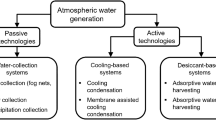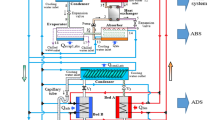Abstract
Drinking water is scarce in many regions of the world despite the omnipresence of water in the form of vapour in large quantities in the atmosphere. Currently, majority of water harvesters use vapour compression refrigeration cycle, which is inefficient. Thus, to reduce electrical energy consumption, the idea proposed in this study is to use a sorption-based atmospheric water generator (AWG) which works on low-grade heat energy. The key component of the proposed AWG is a desiccant-coated fin tube heat exchanger (DCFTHX) which humidifies and heats the air to such an extent that the vapour present in the air can be condensed by simply bringing it in thermal contact with a surface at atmospheric temperature. Thermodynamic modelling of the proposed AWG is first presented, followed by a systematic study under various weather conditions ranging from temperatures of 6 °C to 40 °C and specific humidity from 0.004 to 0.22 kg kg d.a.−1. Results indicate that water can be produced even for specific humidity of 4 kg kg d.a.−1 (near zero dew point temperature) if the ambient temperature is low (10 °C), at regeneration temperatures of 60 and 70 °C. The highest rate of water extraction and the highest yield is 10.9 g s−1 and 62.2 kg kWh−1, respectively, under ambient conditions of 26 °C and 0.02 kg kg d.a.−1. Under the winter (when the absolute humidity is at its lowest) weather conditions of Dubai, as much as 39.3 kg of water can be produced per kWh, which translates to only 0.59 cents per kg water produced.












Similar content being viewed by others
Abbreviations
- A :
-
Area (m2)
- C p :
-
Specific heat (J kg−1 K−1)
- D :
-
Mass diffusivity (m2s−1)
- d :
-
Diameter (m)
- f d :
-
Mass fraction of sorbent
- h :
-
Heat transfer coefficient (W m−2 K−1)
- H :
-
Height or thickness (m)
- h m :
-
Mass transfer coefficient (m s−1)
- k :
-
Thermal conductivity (W m−1 K−1)
- L :
-
Length of heat exchanger (m)
- ṁ :
-
Mass flow rate (kg s−1)
- P f :
-
Pitch (m)
- q″gen :
-
Heat flux (W m−2)
- q ads :
-
Sorption heat (J kg−1)
- r :
-
Tube radius (m)
- r 2 :
-
Outer radius of the equivalent annular fin (m)
- RH:
-
Relative humidity
- T :
-
Temperature (°C)
- t :
-
Time (s)
- U fr :
-
Frontal velocity (m s−1)
- W :
-
Sorbate uptake
- X l :
-
Longitudinal tube-pitch (m)
- X t :
-
Transverse tube-pitch (m)
- Y :
-
Absolute humidity
- ε d :
-
Desiccant porosity
- η :
-
Efficiency
- \({\eta }_{\text{m}}\) :
-
Efficiency of heat exchanger when no condensation occurs
- ρ :
-
Density (kg m−3)
- ∆P :
-
Pressure drop (Pa)
- υ r :
-
Pore radius of the desiccant (m)
- 0:
-
Initial value (t = 0)
- 1:
-
During dehumidification time period
- 2:
-
During regeneration time period
- i:
-
Inner
- o:
-
Outer
- a:
-
Air
- app:
-
Apparent
- b:
-
Blower
- c:
-
Cold
- d:
-
Desiccant or sorbent
- de:
-
Dehumidification
- eq:
-
Equivalent
- f:
-
Fin
- h:
-
Hot
- in:
-
In/inlet
- o:
-
Out/outer
- p:
-
Pump
- re:
-
Regeneration
- s:
-
Surface
- s-avg:
-
Spatially averaged quantity
- t:
-
Tube
- v:
-
Vapour
- w:
-
Water
- DPT:
-
Dew point temperature
- DCFTHX:
-
Desiccant-coated fin tube heat exchanger
- FTHX:
-
Fin tube heat exchanger
- AWG:
-
Atmospheric water generator
- RH:
-
Relative humidity
References
Yilmaz G, et al. Autonomous atmospheric water see** MOF matrix. Sci Adv. 2020;6(42):eabc8605. https://doi.org/10.1126/sciadv.abc8605.
Ejeian M, Wang RZ. Adsorption-based atmospheric water harvesting. Joule. 2021;5(6):1678–703.
Tu Y, Wang R, Zhang Y, Wang J. Progress and expectation of atmospheric water harvesting. Joule. 2018;2(8):1452–75. https://doi.org/10.1016/j.joule.2018.07.015.
Al Hosari T, et al. The UAE cloud seeding program: a statistical and physical evaluation. Atmosphere. 2021;12(8):1013. https://doi.org/10.3390/atmos12081013.
Kumar KN, Suzuki K. Assessment of seasonal cloud properties in the United Arab Emirates and adjoining regions from geostationary satellite data. Remote Sens Environ. 2019;228:90–104. https://doi.org/10.1016/j.rse.2019.04.024.
Bruintjes RT. A review of cloud seeding experiments to enhance precipitation and some new prospects. Bull Am Meteor Soc. 1999;80(5):805–20. https://doi.org/10.1175/1520-0477(1999)080%3c0805:AROCSE%3e2.0.CO;2.
Guadarrama-Cetina J, et al. Dew condensation on desert beetle skin. Eur Phys J E. 2014;37(11):109. https://doi.org/10.1140/epje/i2014-14109-y.
Magrini A, Cattani L, Cartesegna M, Magnani L. Integrated systems for air conditioning and production of drinking water – preliminary considerations. Energy Procedia. 2015;75:1659–65. https://doi.org/10.1016/j.egypro.2015.07.406.
Sharan G, Beysens D, Milimouk-Melnytchouk I. A study of dew water yields on Galvanized iron roofs in Kothara (North-West India). J Arid Environ. 2007;69(2):259–69. https://doi.org/10.1016/j.jaridenv.2006.09.004.
Ketaki Desai Read more at: http://timesofindia.indiatimes.com/articleshow/70005206.cms?utm_source=contentofinterest&utm_medium=text&utm_campaign=cppst, ‘These companies are making drinking water from thin air’, Times of India, Jun. 30, 2019. [Online]. https://timesofindia.indiatimes.com/home/sunday-times/these-companies-are-making-drinking-water-from-thin-air/articleshow/70005206.cms
Bergmair D, Metz SJ, De Lange HC, Van Steenhoven AA. System analysis of membrane facilitated water generation from air humidity. Desalination. 2014;339:26–33. https://doi.org/10.1016/j.desal.2014.02.007.
Zhao LH, Wang RZ, Ge TS. Desiccant coated heat exchanger and its applications. Int J Refrig. 2021;130:217–32. https://doi.org/10.1016/j.ijrefrig.2021.06.008.
Tu R, Liu M, Wang S, Yang X. Performance analyses and optimizations of desiccant wheel-assisted atmospheric water harvesting systems based on ideal thermodynamic cycles. Energy Convers Manag. 2021;245: 114540. https://doi.org/10.1016/j.enconman.2021.114540.
Milani D, Qadir A, Vassallo A, Chiesa M, Abbas A. Experimentally validated model for atmospheric water generation using a solar assisted desiccant dehumidification system. Energy Build. 2014;77:236–46. https://doi.org/10.1016/j.enbuild.2014.03.041.
Qi H, et al. An interfacial solar-driven atmospheric water generator based on a liquid sorbent with simultaneous adsorption–desorption. Adv Mater. 2019;31(43):1903378. https://doi.org/10.1002/adma.201903378.
Gido B, Friedler E, Broday DM. Liquid-desiccant vapor separation reduces the energy requirements of atmospheric moisture harvesting. Environ Sci Technol. 2016;50(15):8362–7. https://doi.org/10.1021/acs.est.6b01280.
Mulchandani A, Malinda S, Edberg J, Westerhoff P. Sunlight-driven atmospheric water capture capacity is enhanced by nano-enabled photothermal desiccants. Environ Sci Nano. 2020;7(9):2584–94. https://doi.org/10.1039/D0EN00463D.
Elashmawy M, Alshammari F. Atmospheric water harvesting from low humid regions using tubular solar still powered by a parabolic concentrator system. J Clean Prod. 2020;256: 120329. https://doi.org/10.1016/j.jclepro.2020.120329.
Shemelin V, Pokorny N, Novotny J. Experimental investigation of silica gel and zeolite coated fin-tube heat exchangers under arid climatic conditions. Energy Rep. 2022;8:331–41. https://doi.org/10.1016/j.egyr.2022.06.115.
Entezari A, Ejeian M, Wang R. Modifying water sorption properties with polymer additives for atmospheric water harvesting applications. Appl Therm Eng. 2019;161: 114109. https://doi.org/10.1016/j.applthermaleng.2019.114109.
Kim H, et al. Adsorption-based atmospheric water harvesting device for arid climates. Nat Commun. 2018;9(1):1191. https://doi.org/10.1038/s41467-018-03162-7.
Kim H, et al. Water harvesting from air with metal-organic frameworks powered by natural sunlight. Science. 2017;356(6336):430–4. https://doi.org/10.1126/science.aam8743.
Entezari A, Ejeian M, Wang R. Super atmospheric water harvesting hydrogel with alginate chains modified with binary salts. ACS Mater Lett. 2020;2(5):471–7. https://doi.org/10.1021/acsmaterialslett.9b00315.
Agrawal A, Kumar A, Parekh AD. Experimental investigation of solar driven atmospheric water generation system based on air-to-air heat exchanger. Energy. 2023;271: 127062. https://doi.org/10.1016/j.energy.2023.127062.
He S, Chen W, Yang W, Zhao X. Review of hygroscopic coating on aluminum fin surface of air conditioning heat exchanger. Appl Sci. 2021;11(11):5193. https://doi.org/10.3390/app11115193.
Vivekh P, Kumja M, Bui DT, Chua KJ. Recent developments in solid desiccant coated heat exchangers—a review. Appl Energy. 2018;229:778–803. https://doi.org/10.1016/j.apenergy.2018.08.041.
Jagirdar M, Lee PS. Mathematical modeling and performance evaluation of a desiccant coated fin-tube heat exchanger. Appl Energy. 2018;212:401–15. https://doi.org/10.1016/j.apenergy.2017.12.038.
Sphaier LA, Worek WM. Analysis of heat and mass transfer in porous sorbents used in rotary regenerators. Int J Heat Mass Transf. 2004;47(14–16):3415–30. https://doi.org/10.1016/j.ijheatmasstransfer.2004.01.016.
Ge TS, Dai YJ, Wang RZ. Performance study of silica gel coated fin-tube heat exchanger cooling system based on a developed mathematical model. Energy Convers Manag. 2011;52(6):2329–38. https://doi.org/10.1016/j.enconman.2010.12.047.
Shah RK, Sekulic DP. Fundamentals of heat exchanger design. New York: Wiley; 2003.
Wang C, Chi K, Chang C. Heat transfer and friction characteristics of plain fin-and- tube heat exchangers, part II : Correlation. Int J Heat Mass Transf. 2000;43:2693–700.
Incropera FP, Incropera FP, editors. Fundamentals of heat and mass transfer. 6th ed. Hoboken: Wiley; 2007.
McQuiston FC, Parker JD, Spitler JD, Taherian H. Heating, ventilating, and air conditioning: analysis and design. New York: Wiley; 2023.
Rishel JB, Durkin TH, Kincaid BL. HVAC pump handbook. 2nd ed. Cambridge: McGraw-Hill; 2006.
Wang F, Yoshida H, Miyata M. Total energy consumption model of fan subsystem suitable for continuous commissioning. ASHRAE Trans. 2004;110(PART 1, Clark 1985):357–64.
Jagirdar M, Lee PS, Padding JT. Performance of an internally cooled and heated desiccant-coated heat and mass exchanger: Effectiveness criteria and design methodology. Appl Therm Eng. 2021;188: 116593. https://doi.org/10.1016/j.applthermaleng.2021.116593.
Acknowledgements
The authors acknowledge the funding support granted by SERB, file number SRG/2021/000887.
Author information
Authors and Affiliations
Contributions
Karandeep Singh contributed to conceptualization of the system, the simulation part of the work and drafting of the results and discussion part; Emma Mariam Punnoose contributed to the literature review and writing of the introduction part as well as analysis of the results; Mrinal K. Jagirdar contributed to the development of the thermal model, conceptualization of the proposed system and final editing.
Corresponding author
Ethics declarations
Conflict of interest
The authors declare that there is no conflict of interest.
Ethical approval
Not applicable.
Consent to participate
Not applicable.
Consent for publication
Not applicable.
Additional information
Publisher's Note
Springer Nature remains neutral with regard to jurisdictional claims in published maps and institutional affiliations.
Rights and permissions
Springer Nature or its licensor (e.g. a society or other partner) holds exclusive rights to this article under a publishing agreement with the author(s) or other rightsholder(s); author self-archiving of the accepted manuscript version of this article is solely governed by the terms of such publishing agreement and applicable law.
About this article
Cite this article
Singh, K., Punnoose, E.M. & Jagirdar, M.K. Thermal modelling and performance evaluation of a low-grade heat-driven sorption-based atmospheric water generator under various weather conditions. J Therm Anal Calorim (2024). https://doi.org/10.1007/s10973-024-13354-7
Received:
Accepted:
Published:
DOI: https://doi.org/10.1007/s10973-024-13354-7




